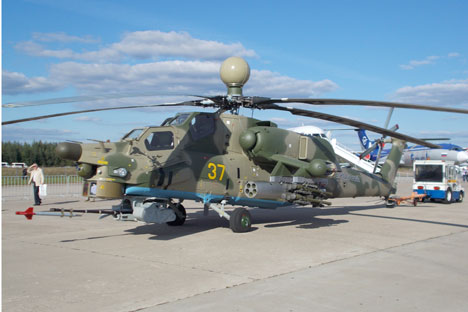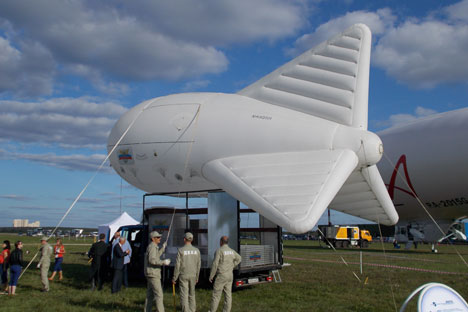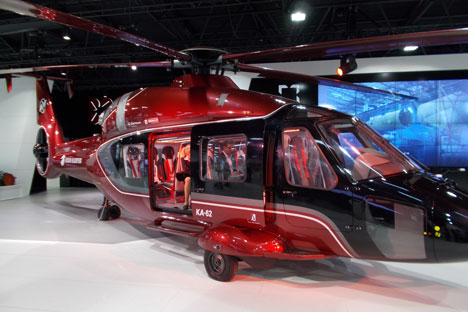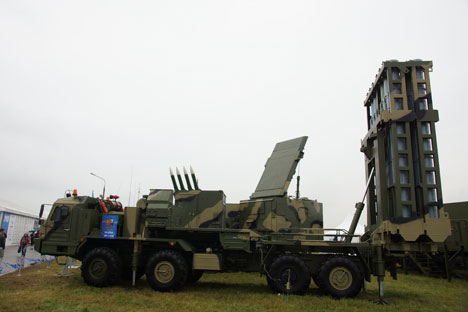
The Mi-28N Night Hunter helicopter. Source: Boris Egorov
Our RBTH correspondent spent two days at the MAKS-2013 international airshow. We present a selection of five of the most interesting innovations from the Russian Military Industrial Complex exhibited at the show in Zhukovskiy in Moscow Region.
A radar system for a Night Hunter
Radio-Electronic Technologies exhibited the NO25E radar system, which has no equivalent in Russia and will be installed in the Mi-28N Night Hunter helicopter. The principle quality of the new radar system is that the receiving array for the transmit/receive module is located above the helicopter’s rotor blades.
On a combat mission and away from shelter, this radar allows the Night Hunter to remain undetected while, at the same time, providing the crew with all the necessary information with split-second timing.
Apart from this, the radar is able to detect objects and weather formations that pose a threat in flight. The radar warns the crew about the threat and sends its coordinates to the onboard radio-electronic equipment, so that it can devise a safe route.
The Tu-214R: One of the most secret aircraft in Russia
As part of the airshow, one of the most secret aircraft in Russia — the Tu-214R — was revealed to the general public for the first time. This radio-electronic and optical-electronic intelligence aircraft was developed back at the end of the 2000s and is based on the Tu-214 passenger aircraft. The first photographs of this aircraft only appeared in the media in May 2012.

The Tu-214R. Source: Olga Sokolova
This aircraft is planned for use in the international Open Skies program, in which participating states have the right to fly over one another’s territory to monitor military activity. Experts think that the Tu-214R should become an alternative to the Il-20M, which has been in service with the Russian army for 40 years.
On the first day of MAKS-2013, Russian Defense Minister Sergei Shoigu inspected the Tu-214R personally. Earlier it was announced that the Ministry of Defense was not planning to purchase the reconnaissance aircraft, because of claims relating to its technical characteristics. It is not yet known if the ministry’s position will change in light of Shoigu’s inspection of the aircraft.
Mobile aerostat systems
The Dolgoprudny Automation Design Bureau presented mobile aerostat systems that were 645 square feet and 860 square feet in volume. They are intended to monitor given geographical areas.

New mobile aerostat systems. Source: Boris Egorov
Any cargo up to 33 pounds in weight — such as communication relay stations, analytical equipment, film cameras and thermal imaging equipment, depending on the requirement — can be attached to them and lifted to an altitude of 1,000 feet. If necessary, these aerostats can be used for military purposes.
These systems can be loaded onto any vehicle with a payload of up to 3 tons and taken to any geographical location. Using mobile aerostat systems to examine forests for fire hazards, or for prolonged monitoring of the condition of specific assets, works out much cheaper than using aircraft or helicopters.
The first prototype example of the Ka-62
The company Russian Helicopters demonstrated the first prototype example of the new, multi-role, Ka-62 helicopter to visitors at MAKS-2013. This helicopter is fitted with the latest avionics, while the airframe and more than half the blades are made from polymer composites.

The Ka-62 helicopter. Source: Boris Egorov
In the long term, this helicopter can be made compatible with the European satellite navigation system Galileo — a European Union and European Space Agency project in which China, Israel, South Korea, Ukraine and Russia are participating.
The Ka-62 is intended to carry 12–14 passengers in a cabin or a 2.5 ton load on an external winch system. These helicopters can be used in the petrochemical industry or to carry out rescue operations. It is expected that certification of the Ka-62 will be completed by the end of 2014, while the first batch of helicopters will be delivered to partners in 2015.
The Vityaz (Knight) air-defense missile system
The air defense company Almaz-Antey displayed the new S-350E, medium-range, air-defense missile system at the airshow. The new generation system works in conjunction with all-aspect radar and a command post based in a BAZ (Bryansk Automobile Plant) vehicle.

The
Vityaz (Knight). Source: Olga Sokolova
Armament includes medium-range missiles used in the S-400 air-defense missile system, as well as short-range missiles.
In the long term, the Vityaz should replace the obsolete S-300, in particular, and supplement Russia’s multi-layered, missile- and air-defense system, of which the new S-400 and S-500 systems will also be a part.
All rights reserved by Rossiyskaya Gazeta.
Subscribe
to our newsletter!
Get the week's best stories straight to your inbox